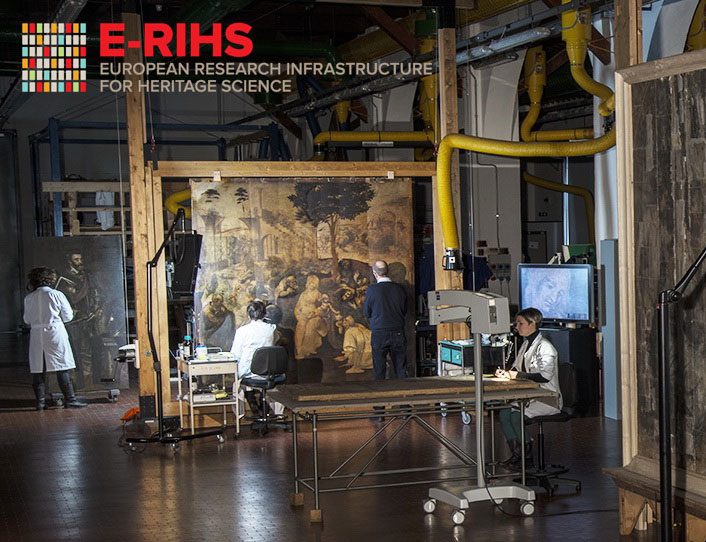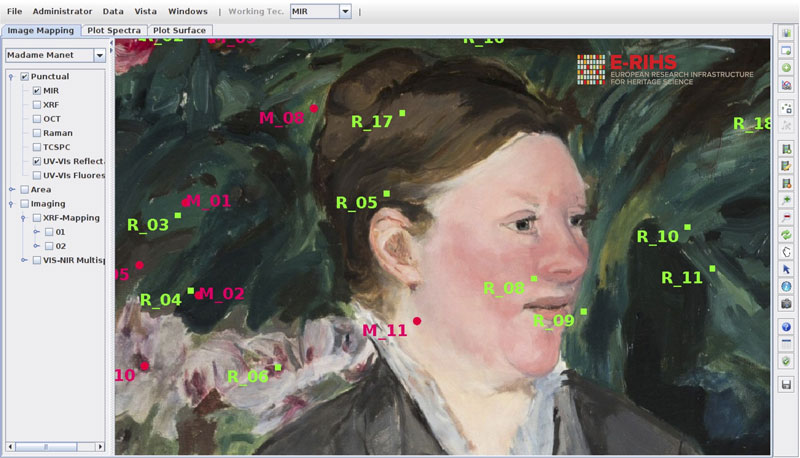by Luca Pezzati and Achille Felicetti (INO-CNR)
The European Research Infrastructure for Heritage Science, E-RIHS [ˈīris], is working to launch DIGILAB: the new data and service infrastructure for the heritage science research community. First services are expected to be online in 2018.
The European Strategic Roadmap for Research Infrastructures (ESFRI Roadmap [L2]), initiated in 2016, is one of the six new projects of the European Research Infrastructure for Heritage Science (E-RIHS)[1]. E-RIHS supports research on heritage interpretation, preservation, documentation and management. Both cultural and natural heritage are addressed: collections, buildings, archaeological sites, digital and intangible heritage. E-RIHS is a distributed research infrastructure: it includes facilities from many countries, organised in national networks and coordinated by national hubs. The E-RIHS Headquarters – to be seated in Florence, Italy – will provide the unique access point to all E-RIHS services.
E-RIHS will provide state-of-the-art tools and services to support cross-disciplinary research communities of users through its four access platforms (Figure 1):
- MOLAB: offers access to advanced mobile analytical instrumentation for diagnostics of heritage objects, archaeological sites and historical monuments. The MObile LABoratories will allow its users to carry out complex multi-technique diagnostic projects, allowing effective in situ investigation.
- FIXLAB: provides access to large-scale and specific facilities with unique expertise in heritage science, for cutting-edge scientific investigation on samples or whole objects, revealing micro-structures and chemical composition, giving essential and invaluable insights into historical technologies, materials and species, their context, chronologies, alteration and degradation phenomena.
- ARCHLAB: enables physical access to archives and collections of prestigious European museums, galleries, research institutions and universities containing non-digital samples and specimens and organised scientific information.
- DIGILAB: facilitates virtual access to tools and data hubs for heritage research – including measurement results, analytical data and documentation – from large academic as well as research and heritage institutions.

Figure 1: Analytical instrumentation for scientific investigation of heritage objects in E-RIHS.

Figure 2: A DIGILAB service for mapping and comparing analysis results to be used for painting restoration and preservation.
E-RIHS will help the preservation of the world’s heritage by enabling cutting-edge research in heritage science, liaising with governments and heritage institutions to promote its continual development and, finally, raising public awareness about cultural and natural heritage and its historic, social and economic significance.
In February 2017, E-RIHS started its preparatory phase supported by the EU project E-RIHS PP (H2020-INFRADEV-02-2016). Representatives of 16 countries (15 from the EU plus Israel) are working together to prepare E-RIHS to be launched as a standalone research infrastructure consortium in 2021.
The DIGILAB platform will provide remote services to the heritage science research community but will also be relevant to and accessible by professionals, practitioners and heritage managers. DIGILAB will enable access to research information as well as to general documentation of analyses, conservation, restoration and any other kind of relevant information about heritage research and background references, such as controlled vocabularies, authority lists and virtual reference collections.
The DIGILAB design takes into account and complies with the EU policies and strategies concerning scientific data, including the FAIR [L3] data principles [1], the Open Research Data [L4] policy, and the EOSC [L5] strategy. DIGILAB will rely on a network of federated repositories where researchers, professionals, managers and other heritage-related professionals deposit the digital results of their work. DIGILAB will not keep those data internally: instead, it will provide access to the original repositories where the data are stored.
DIGILAB is inspired by the FAIR data principles: it will enable Finding data through an advanced search system operating on a registry containing metadata describing each individual dataset; it will support Access to the data through a federated identity system, while data access grants will be local to each repository; it will guarantee data Interoperability by requiring the use of a standard data model; finally, it will foster Re-use by making services available to users, to process the data according to their own research questions and use requirements.
Data policies are relatively new to the heritage science sector. In many cases digital data are still considered disposable: they are used as long as the research continues, then disposed of. They are often stored in inaccessible systems, like personal hard disks or other storage devices, and are thus quickly rendered unusable through the lack of proper documentation, the obsolescence of the software used to create and manage them or, simply, the degradation of storage hardware, which after some time becomes unreadable either because it ceases to function or because it can no longer be connected to more advanced devices.
On the other hand, most of this valuable information can be easily recovered and organised into usable archives. This often requires a handicraft approach, tailored to each dataset and dependent on the humans who created it and who are still available to provide the necessary information. DIGILAB will set up guidelines for dataset recovery and assist researchers and research institutions willing to undertake such tasks.
The cloud-based DIGILAB infrastructure, enhanced by the adoption of international standards and modern IT solutions, will provide the necessary flexibility for the efficient aggregation, interoperability implementation and integration management of huge amounts of scientific data, in order to foster their publication and redistribution in various formats, in accordance with the related policies. The complex semantic graph built in the DIGILAB registry will be able to trace new research paths through scientific concepts by means of the efficient use of semantic relationships linking the entities involved in scientific research; this will provide DIGILAB users with new tools for the discovery, access, and re-use of relevant information (Figure 2).
DIGILAB is designed to be the privileged gateway to European scientific knowledge in heritage, in preparation for becoming the main international portal for heritage science research.
Links:
[L1] http://www.esfri.eu/
[L3] https://kwz.me/hTO
[L4] https://kwz.me/hm0
[L5] https://kwz.me/hm1
Reference:
[1] M. D. Wilkinson, et al.: “The FAIR Guiding Principles for scientific data management and stewardship”, Sci. Data 3:160018, 2016, doi: 10.1038/sdata.2016.18
Please contact:
Luca Pezzati, Achille Felicetti, CNR INO – Istituto Nazionale di Ottica, Italy, +390552308279,











